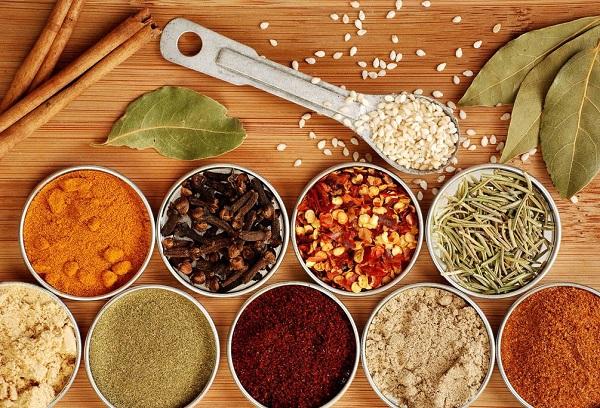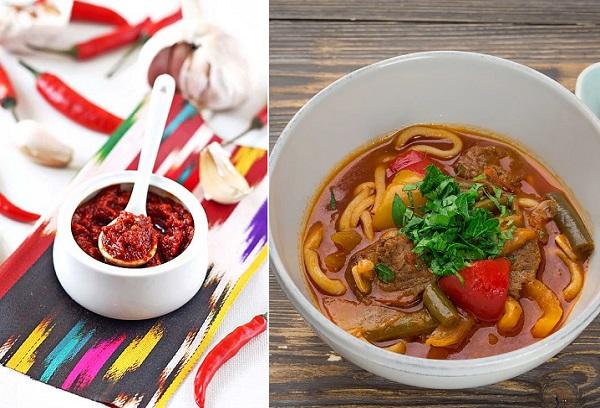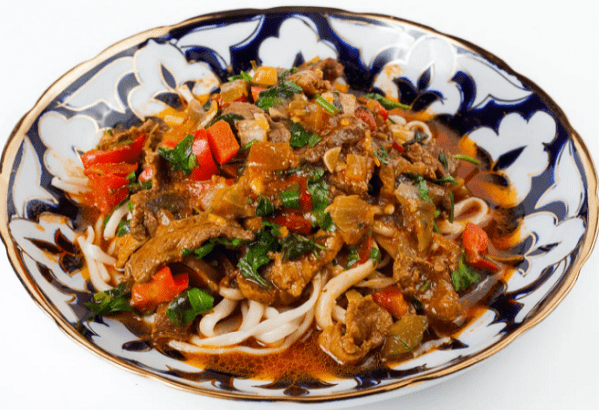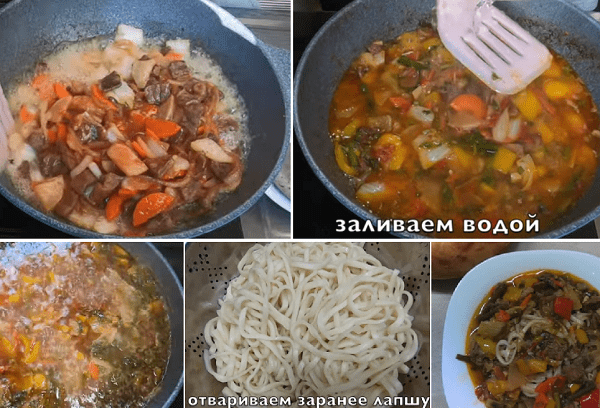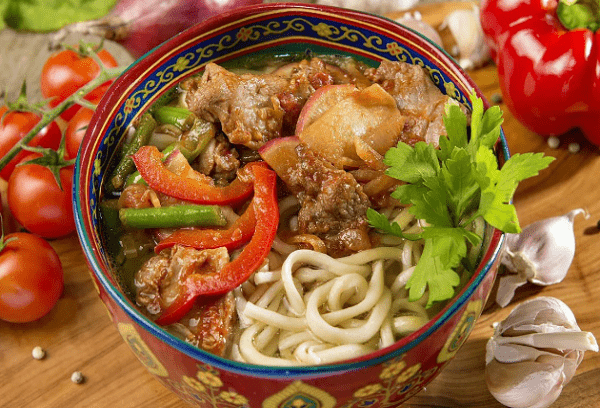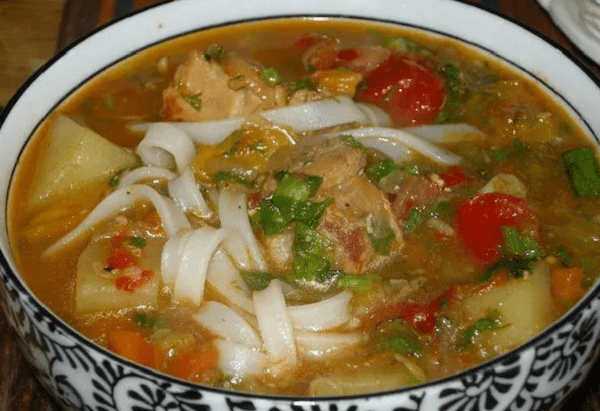What spices are suitable for lagman: authentic recipes and possible variations
Seasoning for lagman is an integral component of the Eastern and Central Asian dish, which has long gained popularity throughout our country.
Lagman itself refers to dishes of Uyghur cuisine, which originates in the northwestern part of China, where a predominantly Muslim population lives. This dish is also common in Kyrgyzstan, Kazakhstan, Turkmenistan and Uzbekistan. And of course, given the multinational composition of Russia, it is no less common in our country.
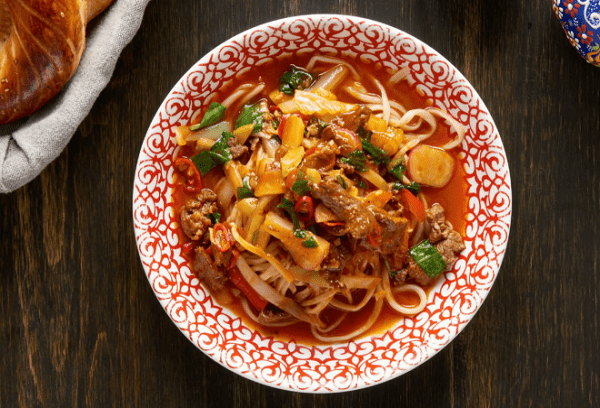
What kind of dishes is lagman?
Lagman is a rich, satisfying dish, the main ingredients of which are meat (usually lamb), vegetables and homemade noodles. This is an amazing combination of soup and roast, the main advantage of which is satiety. The composition and taste may differ depending on the region of preparation and primarily due to the set of spices and herbs used in cooking.
The most popular spices and seasonings for lagman
There are many authentic and original lagman recipes. They differ in types of meat (lamb, beef), a set of vegetables and spices.
Comment! Since the dish belongs to Muslim cuisine, pork is not used in its preparation.
If we talk about spices, the most common ones found in recipes are:
- black and red pepper;
- turmeric;
- ginger;
- star anise (stars);
- cumin;
- coriander.
Greens may require garlic, cilantro, celery, basil and jusai.
Classic spice set
The authentic lagman recipe consists of 2 parts: homemade noodles, stretched in a special way and waju. Vaja is a special sauce, which is meat fried with tomatoes, herbs and spices. The waja must be accompanied by the addition of jusai, a type of onion with a bright garlic aroma.
The vaja also contains turmeric, ground ginger, cumin, hot pepper (red and black), coriander and star anise. The latter are added whole, not ground. Once the waja is ready, prepared noodles and fresh herbs are added to it to make the dish as flavorful as possible.
Laza Chang seasoning
Laza-chang is a traditional spicy seasoning for lagman, also known as “Uighur jam”. You can buy it in a store or prepare it yourself, adjusting the amount of spices to suit your taste.
To do this you need:
- Peel and grind 3 cloves of garlic and a pinch of coriander seeds in a mortar.
- Add one tablespoon of ground red pepper to the mixture.
- Transfer the mixture to a frying pan with hot vegetable oil (30 ml).
- Quickly fry and add a spoonful of the broth left after boiling the noodles.
- Remove the pan from the heat, pour in 30 ml of rice vinegar and add a pinch of sesame seeds.
If we talk about the recipe, the most famous are lagman in Uyghur, Tajik and Uzbek.
Lagman in Uyghur
Lagman in Uyghur is often called the ancestor of all lagmans. It differs from the others not only in its composition, but also in the way the ingredients are cut. Compared to the Uzbek version, the Uyghur dish does not contain potatoes. Unlike the Tajik lagman, eggplants are also not added here.But it contains petsai - a crop better known to us as “Peking cabbage”.
To prepare lagman in Uyghur style you will need:
- lamb – 500-600 g;
- sweet and hot peppers - 1 pc.;
- daikon - ½ pcs.;
- onion (large) – 2 pcs.;
- petsai (core) – ⅔ pcs.;
- celery (stem) – 1 pc.;
- tomatoes – 3-4 pcs.;
- green beans – 5-6 pcs.;
- meat broth – 250 ml;
- oil for frying.
The seasoning is collected separately, which necessarily includes:
- ground coriander - a pinch;
- star anise – 1 star;
- garlic – 5-6 cloves;
- wild garlic – 5 stems;
- ground black pepper - a pinch;
- zira – a pinch.
The main distinguishing features of the Uyghur dish are the thickness of the gravy, a large number of vegetables and the method of cutting the ingredients (into strips).
As you can see, there are not many spices in the Uyghur version. Their small amount is compensated by herbs: parsley, dill, cilantro, garlic and onion. It is thanks to the greens that the dish has a unique aroma. It is important to maintain proportions so that the ingredients do not interrupt each other’s taste.
How to cook:
- Cut the lamb into thin strips, add salt and sprinkle with a mixture of ground coriander and pepper.
- Wash sweet and hot peppers, remove seeds and cut into long thin slices.
- Cut the peeled daikon into strips, Chinese cabbage and onions into rings.
- Remove the leaves from the celery stalk and cut it into small strips.
- Peel the garlic cloves, wash the beans and wild garlic and finely chop all these ingredients.
- First scald the tomatoes, remove the skin and cut into large slices.
- Heat vegetable oil in a cauldron, throw in a star anise and fry it until dark.
- After removing the star anise, add the lamb to the cauldron.
- Stir the meat constantly, and as soon as it changes color, add the remaining vegetables.
- Mix everything well, add spices and broth.
- Cover the cauldron with a lid, and maintaining low heat, leave to simmer for 1.5 hours.
In the meantime, you need to boil the homemade noodles. Before serving, combine the sauce with the noodles and add finely chopped herbs.
Lagman in Uzbek
The main difference between the Uzbek version of the dish is that it contains potatoes, which makes it even more satisfying.
Required:
- beef – 400 g;
- onions – 2 pcs.;
- tomatoes – 3 pcs.;
- carrots – 4 pcs.;
- sweet pepper – 3-4 pcs.;
- potatoes – 4 pcs.;
- vegetable oil for frying.
Spices you should stock up on:
- garlic – 5-6 cloves;
- black pepper - to taste;
- ground coriander and cumin - a pinch each;
- basil - to taste;
- dill - to taste.
How to cook:
- Dry the beef and cut into small cubes.
- Peel the carrots and onions, remove the seeds from the sweet pepper, and chop everything into cubes.
- Scald the tomatoes, peel them and cut them into cubes.
- Finely chop the garlic.
- Add oil to a hot deep frying pan, then add the meat there and fry it for 3-4 minutes (until the color changes).
- Add vegetables, spices, mix everything well and cover with a lid, leave to simmer over low heat for 1.5 hours (add 200 ml of water if necessary).
- Peel and dice the potatoes and add them 30-40 minutes before they are ready.
Boil the noodles, drain the water and add a piece of butter to the still hot pan. Place the noodles in deep plates, pour over the meat and vegetable sauce and sprinkle with finely chopped herbs.
Lagman in Tajik
The Tajik recipe resembles the Uyghur one with the difference that it contains eggplant and chickpeas.
Required:
- beef – 500-600 g;
- sweet pepper – 1 pc.;
- carrots – 1 pc.;
- eggplant - 1 pc.;
- onion (large) – 1 pc.;
- chickpeas – 50 g;
- tomatoes – 2 pcs.;
- green beans (can be frozen) – 100 g;
- meat broth or water – 250 ml;
- oil for frying.
From spices and seasonings you should stock up on the following:
- garlic – 3 cloves;
- cumin - ½ teaspoon;
- ground black pepper - to taste.
How to cook:
- Pour hot water (boiling water) over the chickpeas and leave for 6 hours.
- Wash the beef, dry it and cut it into small pieces.
- Chop the onion, sweet pepper and carrot into strips, and chop the eggplant into large cubes.
- Scald the tomatoes, remove the skin and cut into large slices.
- Heat the oil in a cauldron and fry the meat.
- After 5 minutes, add vegetables in the following order: onions and carrots, then eggplant, pepper, tomato, beans and chickpeas. The intervals between the introductions of vegetables are 3-5 minutes.
- Add the chopped garlic last, mix everything and cover with a lid, leaving for 2-3 minutes to warm up.
- Pour broth or water into the cauldron so that the liquid covers the meat and vegetables, close the lid and leave for 1.5 hours.
Boil the noodles in salted water and serve them with meat sauce and sprinkled with herbs.
Despite the impressive amount of ingredients, preparing a rich, aromatic lagman is not so difficult. Any authentic recipe can be the basis, and the variety of spices used will allow you to create a dish based on your taste preferences.
